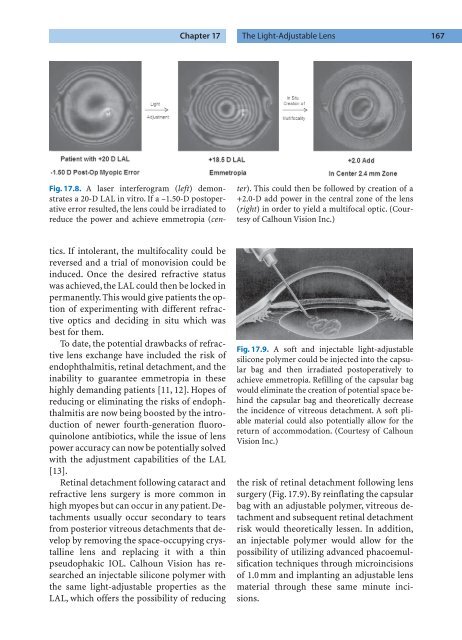Refractive Lens Surgery
Refractive Lens Surgery
Refractive Lens Surgery
You also want an ePaper? Increase the reach of your titles
YUMPU automatically turns print PDFs into web optimized ePapers that Google loves.
Fig. 17.8. A laser interferogram (left) demonstrates<br />
a 20-D LAL in vitro. If a –1.50-D postoperative<br />
error resulted, the lens could be irradiated to<br />
reduce the power and achieve emmetropia (cen-<br />
tics. If intolerant, the multifocality could be<br />
reversed and a trial of monovision could be<br />
induced. Once the desired refractive status<br />
was achieved, the LAL could then be locked in<br />
permanently. This would give patients the option<br />
of experimenting with different refractive<br />
optics and deciding in situ which was<br />
best for them.<br />
To date, the potential drawbacks of refractive<br />
lens exchange have included the risk of<br />
endophthalmitis, retinal detachment, and the<br />
inability to guarantee emmetropia in these<br />
highly demanding patients [11, 12]. Hopes of<br />
reducing or eliminating the risks of endophthalmitis<br />
are now being boosted by the introduction<br />
of newer fourth-generation fluoroquinolone<br />
antibiotics, while the issue of lens<br />
power accuracy can now be potentially solved<br />
with the adjustment capabilities of the LAL<br />
[13].<br />
Retinal detachment following cataract and<br />
refractive lens surgery is more common in<br />
high myopes but can occur in any patient. Detachments<br />
usually occur secondary to tears<br />
from posterior vitreous detachments that develop<br />
by removing the space-occupying crystalline<br />
lens and replacing it with a thin<br />
pseudophakic IOL. Calhoun Vision has researched<br />
an injectable silicone polymer with<br />
the same light-adjustable properties as the<br />
LAL, which offers the possibility of reducing<br />
Chapter 17 The Light-Adjustable <strong>Lens</strong> 167<br />
ter). This could then be followed by creation of a<br />
+2.0-D add power in the central zone of the lens<br />
(right) in order to yield a multifocal optic. (Courtesy<br />
of Calhoun Vision Inc.)<br />
Fig. 17.9. A soft and injectable light-adjustable<br />
silicone polymer could be injected into the capsular<br />
bag and then irradiated postoperatively to<br />
achieve emmetropia. Refilling of the capsular bag<br />
would eliminate the creation of potential space behind<br />
the capsular bag and theoretically decrease<br />
the incidence of vitreous detachment. A soft pliable<br />
material could also potentially allow for the<br />
return of accommodation. (Courtesy of Calhoun<br />
Vision Inc.)<br />
the risk of retinal detachment following lens<br />
surgery (Fig. 17.9). By reinflating the capsular<br />
bag with an adjustable polymer, vitreous detachment<br />
and subsequent retinal detachment<br />
risk would theoretically lessen. In addition,<br />
an injectable polymer would allow for the<br />
possibility of utilizing advanced phacoemulsification<br />
techniques through microincisions<br />
of 1.0 mm and implanting an adjustable lens<br />
material through these same minute incisions.



